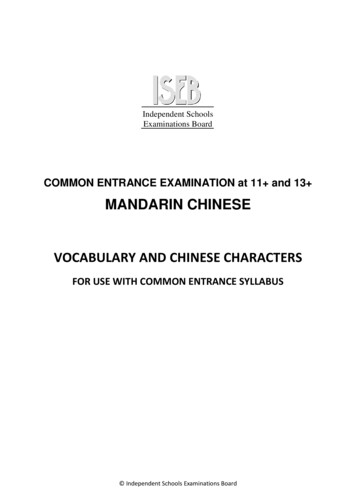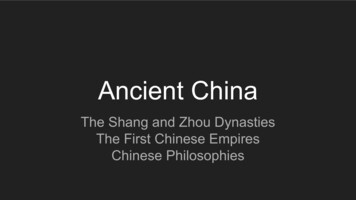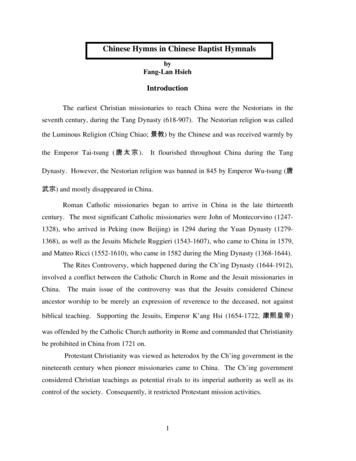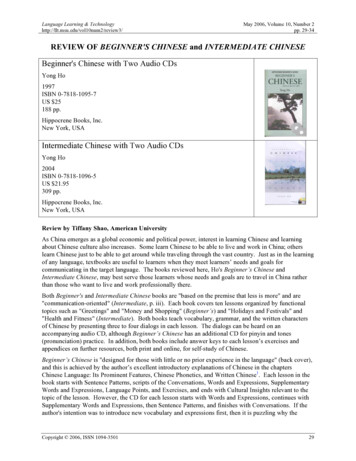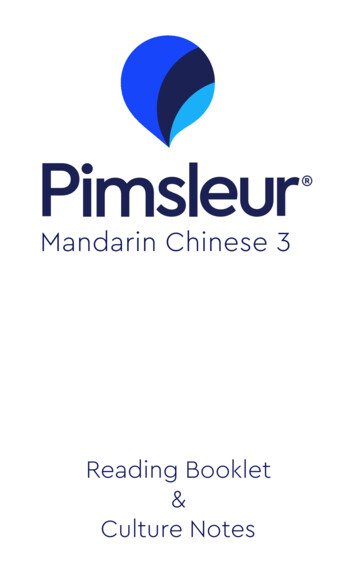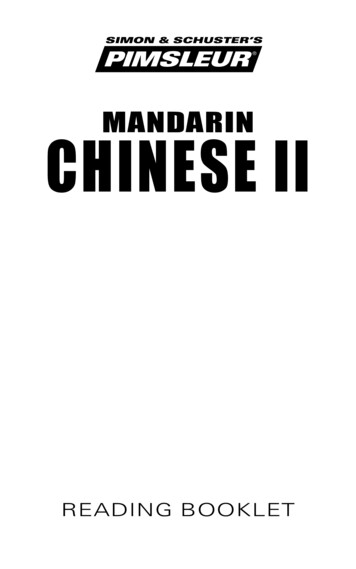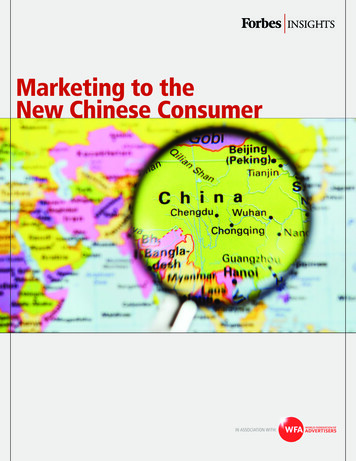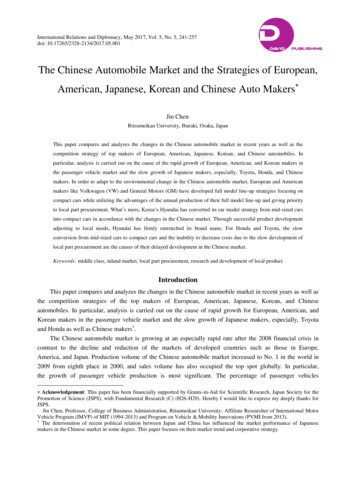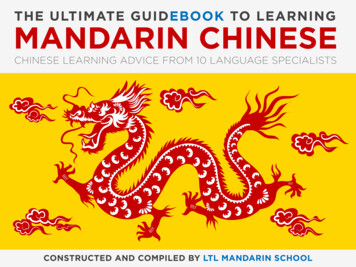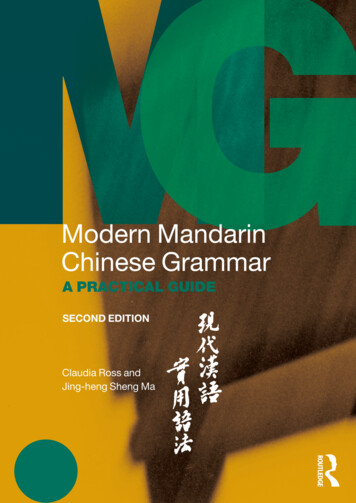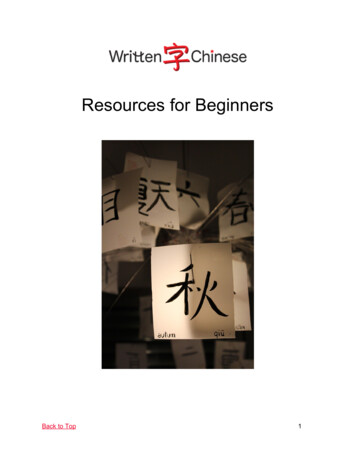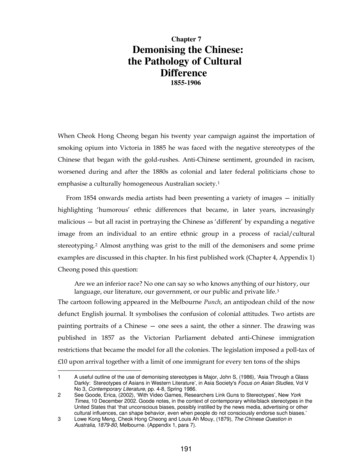
Transcription
Chapter 7Demonising the Chinese:the Pathology of CulturalDifference1855-1906When Cheok Hong Cheong began his twenty year campaign against the importation ofsmoking opium into Victoria in 1885 he was faced with the negative stereotypes of theChinese that began with the gold-rushes. Anti-Chinese sentiment, grounded in racism,worsened during and after the 1880s as colonial and later federal politicians chose toemphasise a culturally homogeneous Australian society. 1From 1854 onwards media artists had been presenting a variety of images — initiallyhighlighting ‘humorous’ ethnic differences that became, in later years, increasinglymalicious — but all racist in portraying the Chinese as ‘different’ by expanding a negativeimage from an individual to an entire ethnic group in a process of racial/culturalstereotyping. 2 Almost anything was grist to the mill of the demonisers and some primeexamples are discussed in this chapter. In his first published work (Chapter 4, Appendix 1)Cheong posed this question:Are we an inferior race? No one can say so who knows anything of our history, ourlanguage, our literature, our government, or our public and private life. 3The cartoon following appeared in the Melbourne Punch, an antipodean child of the nowdefunct English journal. It symbolises the confusion of colonial attitudes. Two artists arepainting portraits of a Chinese — one sees a saint, the other a sinner. The drawing waspublished in 1857 as the Victorian Parliament debated anti-Chinese immigrationrestrictions that became the model for all the colonies. The legislation imposed a poll-tax of 10 upon arrival together with a limit of one immigrant for every ten tons of the ships123A useful outline of the use of demonising stereotypes is Major, John S, (1986), ‘Asia Through a GlassDarkly: Stereotypes of Asians in Western Literature’, in Asia Society's Focus on Asian Studies, Vol VNo 3, Contemporary Literature, pp. 4-8, Spring 1986.See Goode, Erica, (2002), ‘With Video Games, Researchers Link Guns to Stereotypes’, New YorkTimes, 10 December 2002. Goode notes, in the context of contemporary white/black stereotypes in theUnited States that ‘that unconscious biases, possibly instilled by the news media, advertising or othercultural influences, can shape behavior, even when people do not consciously endorse such biases.’Lowe Kong Meng, Cheok Hong Cheong and Louis Ah Mouy, (1879), The Chinese Question inAustralia, 1879-80, Melbourne. (Appendix 1, para 7).191
burthen. The Act set the pattern of discriminitory practice against Chinese and other nonEuropeans that became infamous as the White Australia Policy.Cheong was angered by the way in which Europeans presented an image of the Chineseas collectively inferior to Europeans. There were many and varied criticisms of the Chinesethat ultimately hinged on the issue of social absorption (assimilation) and the colonialunderstanding of morality defined in puritanical European Christian terms. A moralitywas expected of the Chinese that, as Cheong pointed out in The Chinese Question,Europeans could not, and did not, claim for themselves.4Australian racism, viewed historically, rests on a three-step framework, i.e, vilificationby word and image; discriminatory legislation and socio-cultural separation; andultimately, acts of violence. Vilification relies on ‘demonising’ a particular group as a basisfor various forms of discrimination that often leads to violence.5 The second step,45Lowe Kong Meng, Cheok Hong Cheong and Louis Ah Mouy, (1879), The Chinese Question inAustralia, 1879-80, Melbourne. (Appendix 1)A helpful introduction to anti-vilification law in Australia is Johns, Louise, (1995), ‘Racial Vilification andICERD in Australia, Murdoch University Electronic Journal of Law, Vol 2, No 1 (April 1995). Note ICERDrefers to the International Covenant on Elimination of All Forms of Racial Discrimination and specifically,Article Four,192
discriminatory legislation and socio-cultural separation, involves attempts to prevent newarrivals while doing nothing to actively integrate those already in Australia. No effort wasmade to teach English to Chinese, for example, other than the voluntary efforts of thechurches. The separation did not, at least officially, include residential segregationalthough for a variety of reasons, Chinese often chose to live in distinctive residential areasor ‘Chinatowns’— a practice common to many immigrant groups.Chinese in Australia, unlike those in North America, were not denied access to communityfacilities, including schools, hospitals, or benevolent homes nor were they denied access tosocial security provisions such as pensions. They were not subjected to the kind ofresidential segregation practiced in North America or, for that matter, in the Europeansettlements in China itself. In day to day living, however, and it must be said partly bychoice, Chinese did not mix with Europeans on any kind of equal ‘playing field’. The netimpact of Australia on most immigrant Chinese was a feeling of living in a constant hazeof suspicion and dislike with, even if citizens or wealthy businessmen, a sense of beingsecond-rate people. This sense of inferiority was heightened by the humiliation of China’sproblems during the 19th century discussed earlier. The influential EncyclopediaBritannica reflected the ‘wisdom’ common among English-speaking peoples of the day.A Chinaman is cold, cunning and distrustful; always ready to take advantage ofthose he had to deal with; is extremely covetous and deceitful, quarrelsome, vindictive, but timid and dastardly. A Chinaman in office is a strange compound ofinsolence and meanness. (with) a total disregard for the truth.6Although there has been a tendency to emphasise the third aspect of racism, i.e., violence,there is little reference to it in contemporary Chinese sources. Unlike contemporaryChinese attitudes to foreigners, violence was never a policy endorsed, covertly or openly,by Australian colonial governments.The issues that most irritated the Chinese were vilification and its companion — socialdiscrimination. They were not the sole victims of prejudice. Aboriginal people suffered farmore and other ethnic minorities, including southern Europeans, were also affected fromtime to time. What made the Chinese situation particularly offensive, as Cheong pointedout whenever he could, was that only the Chinese, as immigrants, had specific legislativeand financial obstructions to their entry into Australia.6refers to the International Covenant on Elimination of All Forms of Racial Discrimination and specifically,Article Four,Cronin, Kathryn, (1982), Colonial Casualties, Melbourne, Melbourne University Press. The modernclassic on the Chinese in 19th century Victoria, p 76.193
In their 1879 paper (Chapter 4), Cheong and his co-authors used reverse‘demonisation’ to illustrate the stupidity of the anti-Chinese arguments being advanced inVictoria. By applying a ‘demonising’ approach to British (and by implication, Australian)society they sought to turn the argument by a rational or educative response:[We] are stigmatized as ‘ignorant pagans’ and ‘filthy barbarians’ by persons whohave never been in China: who know nothing of its moral, intellectual and social life,and who form hasty judgements and entertain violent prejudices against its peoplefrom a very slight acquaintance with immigrants. Although we deplore as much asany fellow-colonist that immorality does exist amongst Chinese residents, at thesame time we would unhesitatingly assert that it does not exist to a greater extentthan amongst the European population.7A 19th century letter from a missionary with the China Inland Mission stated that viewsabout the Chinese expressed by an Australian were:utterly misleading as regards the Chinese nation. I fear it is written under a strongbias against them, and it is written in evident ignorance of the Chinese as a nation. . . that ‘the 50,000 Chinese at present in Australia’ are like ‘lepers’ or ‘vipers’ in thebosoms of the Australians is an utter untruth.8The letter was a reminder that anti-Chinese vilification in Australia was reported in Chinaamong Chinese and European. It demonstrates an enduring element of 19th century racialvilification in Australia that, in addition to vilifying ‘strange ways’ identified the Chineseas ‘the’ source of various diseases of which smallpox and leprosy were the mostcommonly mentioned.9 Susan Craddock sums up attitudes in San Francisco but herremarks apply equally to Australia:Disease has been one significant factor utilized throughout history by variouspolitical and social institutions to define bodies, control their movements, andsolidify culturally-produced definitions of gender, race, or sexuality. . .10The image opposite appeared in a Queensland journal and is one of the ugliest antiChinese images published in the English-speaking world.11 The Chinese skeleton, symbol7891011Lowe Kong Meng, Cheok Hong Cheong and Louis Ah Mouy, (1879), The Chinese Question inAustralia, 1879-80, Melbourne. (Appendix 1)Robertson, D M in The Spectator, 8 February 1889.Campbell, Judy, (2002), Invisible Invaders: Smallpox and Other Diseases in Aboriginal Australia: 17801880, Carlton, Melbourne University Press.Craddock, Susan, (1999), City of Plagues: Disease, Poverty and Deviance in San Francisco, Universityof Minnesota Press.Griffiths, Phil, (2002). ‘Towards White Australia: The shadow of Mill and the spectre of slavery in theth1880s debates on Chinese immigration,’ Paper presented to the 11 Biennial National Conference ofthe Australian Historical Association, Brisbane, 4 July 2002. This paper, and the next, exemplifies amovement to shift at least some of the accountability for anti-Chinese racism in Australasia from thelabour movement to the capitalist-ruling class.Small, Jerome, (n.d), ‘Reconsidering White Australia. Class and racism in the 1873 Clunes tions/raceriots.htm The argument tends to see the capitalistelite using legislative measures to achieve their goals. A paper on the anti-Chinese riots at Clunes in194
of death, is heating the fire of immorality, want, and disease to spread sickness anddiseases among the European population. As in the cartoon illustrating the horrorsawaiting missionaries (Chapter 5) this and other cartoons provided powerful emotionaltriggers to anti-Chinese vilification, adding sexual envy or fear to the other ‘demons’ beingaroused by the anti-Chinese advocates. The use of virginal young European women assymbols of Chinese concupiscense added to the deliberate ugliness of the imagery and thedenigration of the Chinese as a community.Victoria makes a similar argument. Both are reflective of revisionist writing in the United States thatargues that labour and capital should share in responsibility for racial policies against the Chinese. It isprobably time to assert that anti-Chinese sentiment was not limited to any section of society. SeeLyman, Stanford M, (2000), The "Chinese Question" and American Labor Historians, New Politics, Vol7, No 4 (new series).195
Utterly unfit for habitation though it be, in this dark, damp and unwholesome state, were found fourwomen of the lowest castewith several Chinamen. This filthy den is said to be used at night by themost depraved races of the Mongolians and to be the scene of orgies which are simple indescribable.Health Inspector’s Report in Bribane Courier, 6th May.QueenslandFigaro, 13 March 1888State Library of VictoriaAccusations about Chinese attitudes to European women were common in colonialnewspapers. If the conventional view of Australian racism illustrated in some of thecartoons in this chapter was to be accepted at face value, an assault on a European womanshould have brought out a lynch gang. That was certainly the outcome facing Ah Yeawhen a mob accused him of assaulting, with intent to rape, a thirteen year old girl at Hell’sHole, near Mansfield. He was saved from a lynching when two mounted constables arrived.12In a case near Glenluce in Victoria, a nine year old girl, Annie Hunt, was missed after12The Daily Telegraph, 12 April 1870.196
school. Suspicion fell on a man named Ah Pew. Evidence was given by his hut-mate AhHow that the girl had come to their hut about 4 o'clock but had left. Ah Pew had left soonafter and returned after about an hour, telling Ah How that he had been to Sheng Yem's tobuy nails. Ah How afterwards saw him hiding his boots under an outside fireplace. Later,the Chinese detective, Fook Sing, questioned Ah Pew about the ownership of a brokenpipe found near the girl’s body.13 Ah Pew was finally executed in Castlemaine Gaol,protesting his innocence to the end.14When a European woman was murdered in Stephen Street, Castlemaine, it was generalknowledge that a man named Hing Tzan was implicated. He was captured by a group ofChinese while trying to conceal himself in bushes near the Chinese camp at EaglehawkWhite Gully. He admitted he was part of a group who had watched her, knew she hadmoney, and had broken into her house to rob her but insisted he had not killed her. Hewas subsequently taken to Melbourne for trial where three other men were named asbeing accessories.15 These two incidents, and the reliance on the law that bothdemonstrate, suggest that the imagery of Chinese lust and pursuit of European womenwas just that, an image, created largely by vilification at all levels of society.Allegations about the Chinese and sexual matters need to be kept in context.Newspapers carried endless reports of vile crimes committed by Europeans againstchildren. Sexual assault on females was an almost everyday offence, and it was frequentlyagainst young girls as in the instance above. Some parents put girls as young as eight ontothe streets and children were found to have contracted venereal disease.16 At least onenew-born baby was found dead each week often as a result of a young woman trying to‘con
language, our literature, our government, . In day to day living, however, and it must be said partly by choice, Chinese did not mix with Europeans on any kind of equal ‘playing field’. The net impact of Australia on most immigrant Chinese was a feeling of living in a constant haze of suspicion and dislike with, even if citizens or wealthy businessmen, a sense of being second-rate people .
